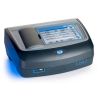Hach Chemical Oxygen Demand (COD) TNTplus Vial Tests
Recommended COD test for wastewater effluent. For determination of Chemical Oxygen Demand (COD) by the Reactor Digestion Method.
Features
- Easy and safe handling
- No reagent blank necessary
- Automatic method detection
- Expedited repair and warranty service
- Lifetime technical support
- More
Recommended COD test for wastewater effluent.
The Chemical Oxygen Demand analysis provides important information for the water treatment process and is essential to calculate the BOD COD ratio in wastewater. Due to this, the COD is one of the most frequently analyzed wastewater parameters globally.
Why should you use Hach TNTplus COD tests? Hach TNTplus COD vial test reagents are incredibly simple to use and cut down significantly on waste generation compared to other COD test kits.
TNT820 is based on Hach Method 10211 for virtually any type of water sample. Hach TNTplus COD vial tests are available in multiple ranges.
TNT820 provides a result in the Ultra Low Range of 1 - 60 mg/L COD and is often used for Chemical Oxygen Demand measurement in wastewater effluent.
Hach TNT820 does not require a separate blanking vial for further waste reduction and is compatible with our ezCOD Waste Recycling Service for further peace of mind.
Method:
For determination of Chemical Oxygen Demand (COD) by the Reactor Digestion Method.
Simply pipette in sample, digest, and read in your Hach Spectrophotometer. 25 tests per box.
Recommended instruments: DR3900 DR6000 DRB200.
- Digestion Required: Yes
- EPA compliant: N/A
- Instrument: DR3900, DR6000, DR1900, DR2800, DR3800, DR5000
- Method: 10211
- Method Name: Reactor Digestion
- Number of tests: 25
- Parameter: COD (Chemical Oxygen Demand)
- Platform: TNT plus™
- Range: 1 - 60 mg/L COD
- Shelf Life: 12 months from production date
- Truecal: Yes
In The News
Supplying Seattle’s Drinking Water: Using Data Buoys to Monitor the Cedar River Municipal Watershed
Providing clean, safe, and reliable drinking water for the 1.6 million people in the greater Seattle area is a top priority for Seattle Public Utilities (SPU). With limited water supplies, SPU dedicates considerable resources to maintain its watersheds and mountain reservoirs. About 70 percent of Seattle Water comes from the Cedar River Municipal Watershed , and the other 30 percent comes from the South Fork Tolt River Watershed . [caption id="attachment_39574" align="alignnone" width="940"] Data buoy in Chester Morse Lake . (Credit: Kevin Johnson / Seattle Public Utilities) [/caption] Jamie Thompson, a fisheries biologist at SPU, monitors aquatic ecosystems centered on fish listed under the U.S. Endangered Species Act (ESA).
Read MoreData-Driven Advocacy on the Lower Deschutes River
Like many freshwater environments, the Deschutes River in Oregon is under pressure from development, pollution, and climate change. Many rivers, streams and lakes in the Deschutes Basin do not meet Oregon water quality standards –where state water quality monitoring assesses levels of bacteria, pH, dissolved oxygen, temperature, and fine sediment. Hannah Camel is the Water Quality Coordinator for the Deschutes River Alliance (DRA), a non-profit organization that focuses on the health of the lower 100 miles of the Deschutes River–the area most affected by human intervention. As a data-driven organization, the DRA has benefited from the installation of two NexSens X2 data loggers.
Read MoreExpanding the Port Everglades: Real-Time Monitoring of Water Quality Conditions from Planned Dredging Operation
The Port Everglades in Broward County, Florida, serves large trade vessels and cruiseliners and incoming and outgoing recreational boaters. However, as cargo ships become larger, the port must expand. A dredging project led by the US Army Corps of Engineers will substantially deepen and widen the port's navigation channel to accommodate larger Panamax cargo ships and modern cruise liners. As a result of this project, a large amount of sediment will be displaced into the water column. This suspended sediment may settle outside of the project area, burying benthic organisms like corals, and possibly carrying harmful particulates to other regions. [caption id="attachment_39497" align="aligncenter" width="2560"] A CB-950 and CB-25 deployed on site at Port Everglades.
Read More

















